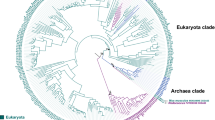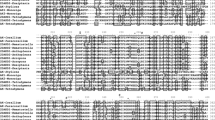Abstract
The primary structures of β-alanopine dehydrogenase (β-AlDH) and tauropine dehydrogenase (TaDH) from the limpet Cellana grata were determined by amino acid sequence analysis and complementary DNA (cDNA) cloning. β-AlDH and TaDH cDNAs comprised 1,479 nucleotides and 1,444 nucleotides, respectively, and both included an open reading frame of 1,206 nucleotides corresponding to 402 amino acids. The enzymes showed very high homology, with 96% amino acid identity. These enzymes were homologous to other marine invertebrate opine dehydrogenases (OpDHs), except TaDH of the marine sponge Halichondria japonica. The highest homologies were to alanopine dehydrogenase from Fusitriton oregonensis, being 57% for both enzymes. A phylogenetic tree constructed on the basis of marine invertebrate OpDHs and developed using a sequence distance method and neighbor-joining algorithm showed a tendency for the classification of animals from taxonomically derived evolutionary trees. Additionally, Cellana grata OpDHs belong to the same group as the Gastropoda OpDHs. This represents the first report concerning the primary structure of marine invertebrate β-AlDH, and primary structure comparisons of clearly different enzymes from the same species.





Similar content being viewed by others
References
Livingstone DR, Stickle WB, Kapper MA, Wang S, Zurburg W (1990) Further studies on the phylogenetic distribution of pyruvate oxidoreductase activities. Comp Biochem Physiol B 97:661–666
Livingstone DR, Zawaan AD, Leopold M, Marteijn E (1983) Studies on the phylogenetic distribution of pyruvate oxidoreductases. Biochem Syst Ecol 11:415–425
Sato M, Takeuchi M, Kanno N, Nagahisa E, Sato Y (1993) Distribution of opine dehydrogenases and lactate dehydrogenase activities in marine animals. Comp Biochem Physiol B 106:955–960
Gäde G, Grieshaber MK (1986) Pyruvate reductases catalyze the formation of lactate and opine in anaerobic invertebrates. Comp Biochem Physiol B 83:255–272
Fields JHA (1983) Alternatives to lactic acid: possible advantages. J Exp Zool 228:445–457
Grieshaber MK, Hardewig I, Kreutzer U, Pörtner HO (1994) Physiological and metabolic responses to hypoxia in invertebrates. Rev Physiol Biochem Pharmacol 125:44–147
Urich K (1994) Comparative animal biochemistry (translated from German by King, P.J.). Springer, Berlin
Kan-no N, Matsu-ura H, Jikihara S, Yamamoto T, Endo N, Moriyama S, Nagahisa E, Sato M (2005) Tauropine dehydrogenase from the marine sponge Halichondria japonica is a homolog ornithine cyclodeaminase/mu-crystallin. Comp Biochem Physiol B 141:331–339
Kimura T, Nakano T, Yamaguchi T, Sato M, Ogawa T, Muramoto K, Yokoyama T, Kan-no N, Nagahisa E, Janssen F, Grieshaber MK (2004) Complementary DNA cloning and molecular evolution of opine dehydrogenases in marine invertebrates. Mar Biotechnol 6:493–502
Endo N, Kan-no N, Nagahisa E (2007) Purification, characterization, and cDNA cloning of opine dehydrogenases from the polychaete rockworm Marphysa sanguinea. Comp Biochem Physiol B 147:293–307
Kanno N, Sato M, Nagahisa E, Sato Y (1996) Application of isoelectric focusing in thin-layer polyacrylamide gels to the study of opine dehydrogenase in marine invertebrates. Fish Sci 62:122–125
Kan-no N, Sato M, Yokoyama T, Nagahisa E (1999) Occurrence of β-alanine specific opine dehydrogenase in the muscle of the limpet Cellana grata Gould (Archaeogastropoda). Comp Biochem Physiol B 123:125–136
Cavins JF, Friedman M (1970) An internal standard for amino acid analysis: S-β-(4-pyridylethyl)-l-cysteine. Anal Biochem 35:489–493
Jeanmougin F, Thompson JD, Gouy M, Higgins DG, Gibson TJ (1998) Multiple sequence alignment with Clustal X. Trends Biochem Sci 2:403–405
Chomczynski P, Sacchi N (1987) Single-step method of RNA isolation by acid guanidinium thiocyanate-phenol-chloroform extraction. Anal Biochem 162:156–159
Sambrook J, Fristch EF, Maniantis T (1989) Molecular cloning: a laboratory manual, 2nd edn. Cold Spring Harbor Laboratory, New York
Tamura K, Dudley J, Nei M, Kumar S (2007) MEGA4: molecular evolutionary genetics analysis (MEGA) software version 4.0. Mol Biol Evol 24:1596–1599
Saitou N, Nei M (1987) The neighbor-joining method: a new method for reconstructing phylogenetic trees. Mol Biol Evol 4:406–425
Seed R (1983) Structural organization, adaptive radiation, and classification of molluscs. In: Hochachka PW (ed) The mollusca. Metabolic biochemistry and molecular biomechanics, vol 1. Academic, New York, pp 1–54
Rossmann MG, Liljas A, Brändén C-I, Banaszak LJ (1975) Evolutionary and structural relationships among dehydrogenases. In: Boyer PD (ed) The enzymes. Academic, New York, pp 61–102
Wierenga RK, De Maeyer MCH, Hol WGJ (1985) Interaction of pyrophosphate moieties with alpha-helixes in dinucleotide-binding proteins. Biochemistry 24:1346–1357
Britton KL, Asano Y, Rice DW (1998) Crystal structure and active site location of N-(1-d-carboxylethyl)-l-norvaline dehydrogenase. Nat Struct Biol 5:593–601
Müller A, Janssen F, Grieshaber MK (2007) Putative reaction mechanism of heterologously expressed octopine dehydrogenase from the great scallop, Pecten maximus (L). FEBS J 274:6329–6339
Smits SH, Müeller A, Schmitt L, Grieshaber MK (2008) A structural basis for substrate selectivity and stereoselectivity in octopine dehydrogenase from Pecten maximus. J Mol Biol 381:200–211
Storey KB (1983) Tissue-specific alanopine dehydrogenase and strombine dehydrogenase from the sea mouse, Aphrodite aculeata (Polychaeta). J Exp Zool 225:369–378
Gäde G (1988) Energy metabolism during anoxia and recovery in shell adductor and foot muscle of the gastropod mollusc Haliotis lamellosa: formation of the novel anaerobic end product tauropine. Biol Bull 175:122–131
Author information
Authors and Affiliations
Corresponding author
Rights and permissions
About this article
Cite this article
Endo, N., Matsu-ura, H. & Kan-no, N. cDNA cloning and primary structure comparison of tauropine dehydrogenase and β-alanopine dehydrogenase from the limpet Cellana grata . Fish Sci 75, 1471–1479 (2009). https://doi.org/10.1007/s12562-009-0178-x
Received:
Accepted:
Published:
Issue Date:
DOI: https://doi.org/10.1007/s12562-009-0178-x




